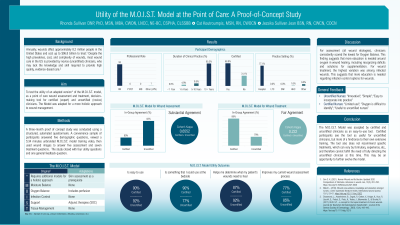Clinical Research
(CR-056) Utility of the M.O.I.S.T. Model at the Point of Care: A Proof-Of-Concept Study

Methods:
This three-month proof of concept study was conducted using a structured, automated questionnaire. A convenience sample of participants answered five demographic questions, viewed a 5:34 minutes unbranded M.O.I.S.T. model training video, then used wound images to answer five assessment and seven treatment questions. The study closed with four utility questions and one general feedback question.
Results:
Participants were registered nurses (n=60), one licensed practical nurse, 68.9% certified, and 31.1% uncertified. In-group agreement for certified and uncertified respectively, was 80 vs 82% for assessment and 89% vs 78% for treatment. Across both groups, there was substantial agreement (Cohen’s Kappa; 0.6552) for assessment and fair agreement (Cohen’s Kappa; 0.222) for treatment. Certified and uncertified clinicians, respectively, strongly agreed or agreed that the M.O.I.S.T. model was easy to use (90% vs 92%); was something that could be used at the bedside (90% vs 77%); helped the clinician determined what the wound needed to heal (87% vs 92%; and improved the current wound care assessment process (77% vs 85%).
Discussion:
This study demonstrates that the M.O.I.S.T. model may have utility at the point of care, primarily in guiding decision making for novice nurses, who provide the majority of wound care to patients.

.jpeg)